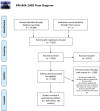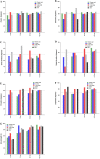Treatment options in extra-articular distal radius fractures: a systematic review and meta-analysis
- PMID: 34009418
- PMCID: PMC9712287
- DOI: 10.1007/s00068-021-01679-z
Treatment options in extra-articular distal radius fractures: a systematic review and meta-analysis
Abstract
Purpose: This systematic literature review aimed to make a detailed overview on the clinical and functional outcomes and to get insight into the possible superiority of a treatment method for extra-articular distal radius fractures.
Methods: Embase, Medline, Cochrane Library, Web of Science, and Google Scholar were searched for studies describing treatment results. Five treatment modalities were compared: plaster cast immobilization, K-wire fixation, volar plating, external fixation, and intramedullary fixation.
Results: Out of 7,054 screened studies, 109 were included in the analysis. Overall complication rate ranged from 9% after plaster cast treatment to 18.5% after K-wire fixation. For radiographic outcomes, only volar tilt in the plaster cast group was lower than in the other groups. Apart from better grip strength after volar plating, no clear functional differences were found across treatment groups.
Conclusion: Current literature does not provide uniform evidence to prove superiority of a particular treatment method when looking at complications, re-interventions, and long-term functional outcomes.
Keywords: Distal radius fractures; Extra-articular; Non-operative; Operative; Review; Treatment.
© 2021. The Author(s).
Conflict of interest statement
The authors declare that they have no competing interests.
Figures







Comment in
-
Diagnostics, incidence and treatment of the distal radius fractures: an area for many studies, opinions and treatment options.Eur J Trauma Emerg Surg. 2022 Dec;48(6):4315-4317. doi: 10.1007/s00068-022-02150-3. Eur J Trauma Emerg Surg. 2022. PMID: 36450839 Free PMC article. No abstract available.
Similar articles
-
Volar locking plates versus K-wire/pin fixation for the treatment of distal radial fractures: a systematic review and quantitative synthesis.Br Med Bull. 2015 Sep;115(1):91-110. doi: 10.1093/bmb/ldv015. Epub 2015 Apr 26. Br Med Bull. 2015. PMID: 25918348
-
Effectiveness of surgical versus conservative treatment of distal radius fractures in elderly patients: A systematic review and meta-analysis.Orthop Traumatol Surg Res. 2022 Sep;108(5):103323. doi: 10.1016/j.otsr.2022.103323. Epub 2022 May 16. Orthop Traumatol Surg Res. 2022. PMID: 35589085
-
Interventions for treating supracondylar elbow fractures in children.Cochrane Database Syst Rev. 2022 Jun 9;6(6):CD013609. doi: 10.1002/14651858.CD013609.pub2. Cochrane Database Syst Rev. 2022. PMID: 35678077 Free PMC article.
-
The comparative risk of developing postoperative complications in patients with distal radius fractures following different treatment modalities.Sci Rep. 2015 Nov 9;5:15318. doi: 10.1038/srep15318. Sci Rep. 2015. PMID: 26549312 Free PMC article.
-
Fibular fixation in mid and distal extra-articular tibia fractures - A systematic review and meta-analysis.Foot Ankle Surg. 2022 Oct;28(7):809-816. doi: 10.1016/j.fas.2021.11.007. Epub 2021 Nov 17. Foot Ankle Surg. 2022. PMID: 34836719
Cited by
-
Diagnostics, incidence and treatment of the distal radius fractures: an area for many studies, opinions and treatment options.Eur J Trauma Emerg Surg. 2022 Dec;48(6):4315-4317. doi: 10.1007/s00068-022-02150-3. Eur J Trauma Emerg Surg. 2022. PMID: 36450839 Free PMC article. No abstract available.
-
Colles' Fracture: An Epidemiological Nationwide Study in Italy from 2001 to 2016.Int J Environ Res Public Health. 2023 Feb 23;20(5):3956. doi: 10.3390/ijerph20053956. Int J Environ Res Public Health. 2023. PMID: 36900966 Free PMC article. Review.
-
Teardrop Alignment Changes After Volar Locking Plate Fixation of Distal Radius Fractures With Volar Ulnar Fragments.Hand (N Y). 2025 Jul;20(5):748-754. doi: 10.1177/15589447241233762. Epub 2024 Mar 4. Hand (N Y). 2025. PMID: 38439630 Free PMC article.
-
Is fracture management merely a physical process? Exploring the psychological effects of internal and external fixation.J Orthop Surg Res. 2024 Apr 8;19(1):231. doi: 10.1186/s13018-024-04655-6. J Orthop Surg Res. 2024. PMID: 38589910 Free PMC article.
References
-
- Costa ML, Achten J, Caroline P, Parsons NR, Rangan A, Tubeuf S, et al. UK DRAFFT: a randomised controlled triaof percutaneous fixation with kirschner wires versus volar locking-plate fixation in the treatment of adult patients with a dorsally displaced fracture of the distal radius. Health Technol Assess. 2015 doi: 10.3310/hta19170. - DOI - PMC - PubMed
Publication types
MeSH terms
LinkOut - more resources
Full Text Sources
Other Literature Sources
Medical
Miscellaneous

